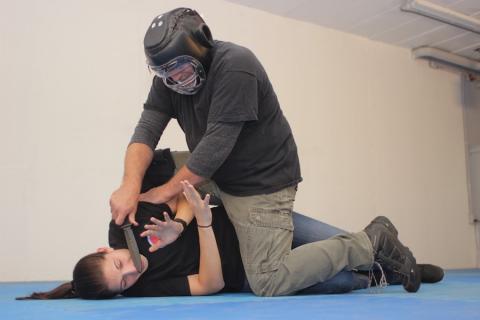The Fight
January 18, 2021
Fights are not static. Things move. People move. Bear-hugs and headlocks and all that stuff happen sometimes in a fight, but they are transitional actions. You do not get bear-hugged just to be held (except by bouncers). A Threat wraps his big arms around you from behind either to pick you up and shake you (disorienting and intended as an intimidating show of strength) or to drive you into a wall. Maybe to throw you over a balcony. If you practice technique-based defense, will they work if the Threat refuses to stand there? If he is using that headlock to slam you from wall to wall?
The Lowest Level of Force
December 7, 2020
The Records area at Rusafa Prison Complex in Baghdad is enclosed by a chain-link fence and was almost always crowded. It’s a stressful place, with inmates being processed in and out, Iraqi military, police, corrections, advocates, politicos, and sometimes families of the convicts are present and a small handful of American advisors.
Simple Drills Worth Knowing
January 30, 2017
The following are important things, some little, some major, that lend themselves well to simple drills or exercises. Backing up is almost never the answer. Unless you are excellent at reading and remembering tactical terrain, you might not know what or who is behind you.
Evaluating Drills—Part 2
October 31, 2016
I get especially annoyed with weapons. Unarmed defense against a weapon sucks. Never, ever, ever practice dying and do not train to be killed. The stakes are too high to blindly imprint a habit, even a habit as simple as handing a weapon back once you have disarmed someone.
Evaluating Drills—Part 1
October 24, 2016
I'm not a big fan of most drills. There is a fine line, but conditioned reflexes are crucial in a fight and habits will get you killed. Conditioned reflexes are things you do without thinking about it. They are essentially trained flinch responses. If something suddenly comes at your eyes you WILL do something: block, move your head or, at the very minimum, blink.
The Doctrine of Purpose
-
December 14, 2009
It is widely accepted that martial arts were originally developed as tools of war intended for use by soldiers on the field of battle.
Remaining True to the Art
-
October 5, 2009
I am always careful to remind my students that the practice of traditional taekwondo is not easy. I tell them that if it were, everyone would train. And it is not difficult to see why.
Violence: What Everyone Needs to Know About Fighting
-
August 2, 2009
According to the Bureau of Justice Statistics, men commit about 80 percent of all violent crimes in the United States, serious stuff like homicides, rapes, robberies, and assaults. Men are twice as likely as women to become victims of those same violent crimes, except for rape.
The Korean Connection: Taekwondo Training in the "Land of the Morning Calm" - Part 3
-
March 16, 2009
Grandmaster Nam is an exceptional instructor, nimbly moving from one component of the taekwondo curriculum to the next. From basic movements he continues on with one-step sparring drills, fourteen in all, ranging from axe kick/round kick combinations to spread block/double upper cut in twist stance techniques
The Korean Connection: Taekwondo Training in the "Land of the Morning Calm" - Part 2
-
March 9, 2009
In what to me represents the epitome of Korean hospitality, our group is invited to the headquarters of the Korean National Tourism Organization in downtown Seoul, for an official welcoming ceremony
The Korean Connection: Taekwondo Training in the "Land of the Morning Calm" - Part 1
-
March 2, 2009
Traditional taekwondo philosophy teaches us to cultivate, among other things, courage, perseverance and indomitable will. Clearly, these virtues go hand in hand with transforming dreams into reality.
Mob Violence Is An Eruption With No Warning
-
February 17, 2009
Gang violence gets a fair amount of copy in the media. But another form of violence is mob violence. Mob violence rises up, explodes, and then recedes.
Meditations on Violence
-
May 22, 2008
People are weird. They have an almost infinite ability to learn and communicate. At the same time, this amazing ability is used as much for fantasy and entertainment as it is for information and survival. Take, for example, the rhinoceros and the unicorn.
- « first
- ‹ previous
- 1
- 2
- 3












